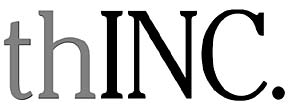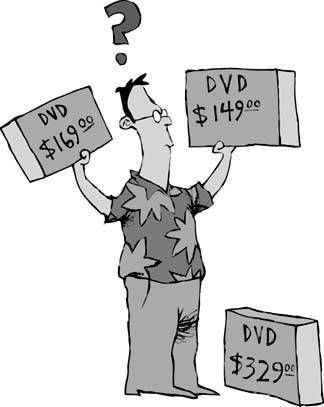

A forum for Hawaii's
business community to discuss
current events and issues
» Pricing psychology » Network your home
BACK TO TOP |
PRICING PSYCHOLOGY
How to quote a price
vs. what price to quote
Imagine that you are shopping for a DVD player and you find two players manufactured by the same company on display. They appear to be quite similar, except for minor styling and packaging differences, and are priced as follows:
Player A Player B $149 $169
Which one do you think is the better seller?With only these two models in the product line, research has shown that model A will outsell the higher priced model B, most customers opting to save money on what appears to be similar products. Now imagine that the manufacturer adds a top-of-the-line model with considerably more features. The new product display looks like this:
Player A Player B Player C $149 $169 $ 329
Now which model do you think will be the best seller? In a similar situation with actual products, model B soon became the best seller. Why do you think this is the case?In the first situation, model B seems expensive at $169 compared to Model A's $149 price. But with the addition of a significantly higher priced model C at $329, model B now seems like a good buy. Psychologically, the $20 step up from model A seems acceptable compared to the whopping $160 increase to model C. As consumers, we now tend to view models A and B as somewhat similar, and we think "I'll go with the slightly more expensive of the two lower-priced models because it's probably a little better quality. But I'm not willing to go all the way up to $329." In addition, we are mentally more comfortable choosing a middle-of-the-road compromise price than either of the more extreme end-point prices. How we perceive a price depends on the context in which it is presented and this is part of the psychology of pricing.
In a similar example, a company with three products in its line found the sales of its top-end product disappointing. Thinking that they must be overpricing the top model, they interviewed customers -- only to find that customers did not think the top-end model was over-priced, they were simply psychologically reluctant to buy the most expensive product in the line. When the company added an even higher priced fourth model, sales of the previous top-end model increased dramatically.
Tips for business
Marketers can influence customers' reactions to product prices by considering the context in which the price is seen.1. When different price alternatives are presented, begin with a regular price and show a discount rather than starting with a lower price and piling on the surcharges. Customers who pay the higher price will be less irritated if they do not qualify for the discount than they would be if hit with a surcharge. For example, advertise gas at $1.96 less a $.10 discount for paying cash rather than $1.86 plus a $.10 surcharge if you pay by credit card. Tourists don't seem to mind too much that they pay the standard price of $150 for a round of golf in Hawaii, even though they might be aware that residents qualify for a reduced fee of $50. On the other hand, imagine how a tourist would feel if told that the regular fee was $50 but they have to pay an extra $100 because they are a tourist.
2. On package deals, list each product separately, but present a package price. Listing each product's benefits separately builds value in the customer's mind, as benefit is piled on top of benefit. But you do not want to appear to be piling cost on top of cost give one price for everything. Packaging, or bundling, products can be done in different ways. A luggage retailer wants to offer a package discount on a $120 garment bag and a $60 duffel bag. One alternative would be to offer both bags for $150 -- a $30 saving (a 16.7 percent discount). However, since research has shown that discounts should be at least 20 percent to increase the incentive to buy, a better psychological alternative would be to offer the duffel bag at $30 off (a 50 percent discount) with the purchase of a garment bag at list price. This type of mixed bundling leads to greater profits.
3. You can charge higher prices for a product if it is part of a larger package. Charging $100 rather than $80 for a set of floor mats seems rather trivial in the context of a $20,000 automobile purchase. In a pricing experiment, buyers were asked whether they would drive 20 minutes to another store to save $5 on a $15 calculator and 68 percent said they would. But when asked if they would make the same effort to save $5 on a $125 jacket, only 29 percent said they were willing to do so. Apparently, $5 seems more trivial in the context of a $125 purchase than a $15 purchase.
4. When advertising a discount, state it in dollars if the price of the product is high, but state it as a percentage if the price of the product is small. An appliance retailer should offer $200 off on refrigerators but 20 percent off on toasters.
5. Using a coupon rather than a discount maintains the original value of the product in customers' minds. A discount can create the impression that the product's value has come down, but a coupon gives the feeling that a strictly temporary bargain is being offered to select customers and the value of the product has not changed.
Ted Haggblom is a marketing professor at Hawaii Pacific University. He is president of PriceLogic Corp. and a director of the Pacific Pricing Institute. He can be reached at 544-0831 or thaggblom@hpu.edu.
BACK TO TOP |
Think about creating a
computer network at home
Nowadays, when you can buy a brand new PC for $500 or less, it's common to see a home with two or more computers. In Hawaii, we're lucky. Both cable modem and DSL connectivity are accessible to most people on all islands. This makes it possible to provide a home network so that everyone in the house has broadband.
However, before you plan a home network there are a number of questions to consider:
>> What type of technology is best to use -- wired or wireless?These concerns can become even more complex when you consider issues such as print and file sharing from within your home network.
>> Will you need to access the Internet in more than one room in your home?
>> Will you be working from home?
>> Will you want a computer connection in an office or extra bedroom in the future?(Do your really want your 9- year-old daughter to use your expensive color printer paper to knock out 200 copies of the latest photos of Justin Timberlake or Ricky Godinez so that she can pass them out to the entire third grade?)
In a series of articles over the next few weeks we'll explore how to plan your home network as well as some pointers to help you avoid some costly mistakes -- some of which I've made myself.
Wired or wireless? This is a key consideration.
Wireless technology usually offers the most convenient solution for most families, but it might not always be the best option.
"Wireless" is a buzzword you can't get away from these days. It has become so popular that you can purchase 802.11b hardware from Costco.
"Wireless" evokes visions of sitting on your lanai, downloading e-mail, or wandering around your home with only a laptop, untethered. It's a pretty cool notion, but often the realty is different.
Why? The design, construction, and layout of your home can directly affect whether wireless will work well. Although wireless vendors may claim coverage of up to several hundred feet, it seldom works exactly that way. In addition to distance, factors such as furniture, walls and other obstructions can impede performance. For example, in my own home, I've had to install access points in various places so everyone can connect.
Multiple access points also may be required in multi-story homes or offices.
Another concern with wireless is data security. Although much has been done to address this issue, whenever you put your data into the air it's vulnerable to hackers.
Wireless does offer the advantages of easier installation. There's no drilling through walls to install cables.
Wired connection, may be klunky and less hip than wireless, but when you look at performance and price it stacks up well. The fastest anyone can trade data on a wireless network is 108 Mbit (www.netgear.com). Compared to the 1,000-Mbit speed offered by Ethernet, it's no contest.
Prices have also dropped precipitously for wired products.
Which to choose?
If your applications are simple -- getting online, printing, file sharing -- and you don't need blazing speed -- wireless might be better. This is especially true if you only have a couple of computers (especially laptops) that are located fairly close to each other. I suspect wireless probably would satisfy the needs of most Hawaii families.
However, if you have special application that need enormous amounts of bandwidth and you don't mind drilling holes in your walls or crawling under your floors to pull cable, then a wired, switched (1,000-Mbit Ethernet) network is a better way to go. It's also less expensive.
In the next column we'll look at what it takes to put a wired network in your home.
Kiman Wong, general manager of Internet services at Oceanic Time Warner Cable, is an engineer by training and a full time computer geek by profession. Questions or comments should be addressed to kiman.wong@oceanic.com.
To participate in the Think Inc. discussion, e-mail your comments to business@starbulletin.com; fax them to 529-4750; or mail them to Think Inc., Honolulu Star-Bulletin, 7 Waterfront Plaza, Suite 210, 500 Ala Moana, Honolulu, Hawaii 96813. Anonymous submissions will be discarded.
